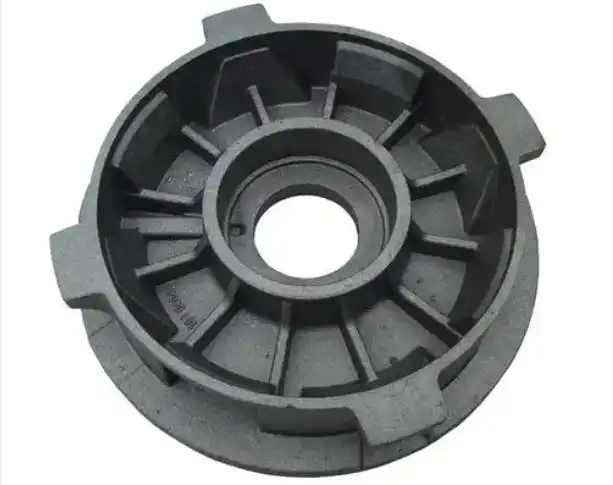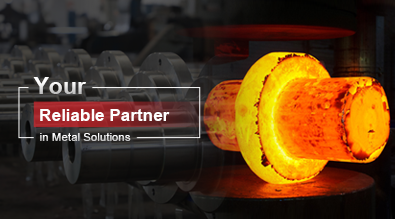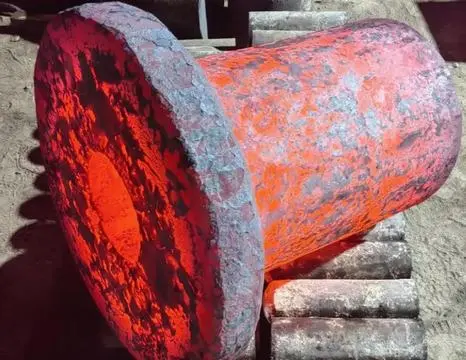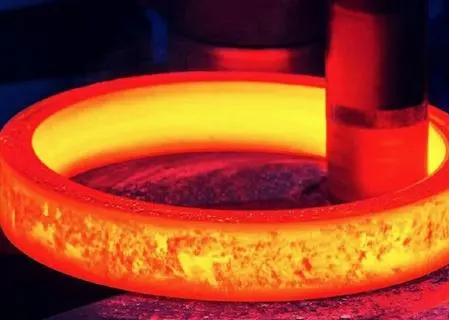What is spheroidal graphite cast iron
Spheroidal graphite cast iron is a type of cast iron that has been metallurgically treated to form graphite into spherical nodules within the iron matrix. This unique microstructure gives spheroidal graphite cast iron exceptional mechanical properties, combining the castability of gray iron with the strength and ductility of steel. As a result, it has become increasingly popular in various industrial applications, from automotive components to heavy machinery parts.

What are the properties of spheroidal graphite cast iron?
Mechanical Strength
Spheroidal graphite cast iron exhibits remarkable mechanical strength, surpassing that of traditional gray cast iron. The spherical graphite nodules act as "crack-stoppers," preventing the propagation of cracks through the material. This characteristic results in a higher tensile strength, typically ranging from 414 to 1380 MPa, depending on the grade. The material also demonstrates excellent fatigue resistance, making it suitable for components subjected to cyclic loading. Furthermore, the ductility of spheroidal graphite cast iron allows for a degree of plastic deformation before failure, providing a safety margin in critical applications. This combination of strength and ductility makes it an ideal choice for structural components in various industries, including automotive, construction, and heavy machinery.
Machinability
One of the key advantages of spheroidal graphite cast iron is its excellent machinability. The presence of graphite nodules in the microstructure acts as a natural lubricant during machining operations, reducing tool wear and improving surface finish. This characteristic allows for easier and more cost-effective manufacturing processes compared to steels of similar strength. The machinability index of spheroidal graphite cast iron is typically higher than that of gray cast iron, making it possible to achieve tighter tolerances and more complex geometries. Additionally, the material's ability to dampen vibrations during machining contributes to improved part quality and reduced manufacturing time. These properties make spheroidal graphite cast iron an attractive option for manufacturers seeking to optimize their production processes while maintaining high-quality standards.
Corrosion Resistance
Spheroidal graphite cast iron demonstrates good corrosion resistance, particularly when compared to other ferrous materials. The graphite nodules in the microstructure create a discontinuous path for corrosion propagation, effectively slowing down the corrosion process. This inherent resistance can be further enhanced through various surface treatments or alloying elements. In marine environments, for example, spheroidal graphite cast iron has shown superior performance to gray cast iron and some grades of stainless steel. The material's corrosion resistance, combined with its mechanical properties, makes it suitable for applications in harsh environments, such as pipelines, pumps, and valves in chemical processing plants. However, it's important to note that the corrosion resistance of spheroidal graphite cast iron can vary depending on the specific grade and environmental conditions, and proper material selection is crucial for optimal performance in corrosive environments.
How is spheroidal graphite cast iron produced?
Raw Materials and Melting Process
The production of spheroidal graphite cast iron begins with the careful selection of raw materials. High-quality pig iron, steel scrap, and ferroalloys are typically used as the base materials. The composition is crucial, with specific attention paid to the carbon and silicon content, as these elements play a significant role in the formation of graphite nodules. The raw materials are melted in a furnace, usually an electric arc furnace or an induction furnace, to ensure precise control over the melt composition and temperature. During the melting process, the temperature is carefully monitored and maintained between 1350°C and 1400°C. Impurities are removed through slag formation and skimming. The molten iron is then subjected to a desulfurization process, as sulfur can interfere with the formation of spheroidal graphite. This initial stage sets the foundation for the unique properties of spheroidal graphite cast iron.
Nodularization Treatment
The key step in producing spheroidal graphite cast iron is the nodularization treatment. This process involves adding a nodularizing agent, typically a magnesium-based alloy, to the molten iron. The addition of magnesium causes the graphite to form spherical nodules instead of flakes, as seen in gray cast iron. The nodularization treatment is a critical and time-sensitive process, often performed in a special ladle or through an in-mold process. The magnesium reacts with the sulfur and oxygen in the melt, forming compounds that float to the surface as slag. The remaining magnesium then promotes the formation of spheroidal graphite as the iron solidifies. The timing and method of magnesium addition are crucial, as the element tends to fade quickly from the melt. Advanced techniques, such as the wire injection method or the use of cored wire containing magnesium, have been developed to optimize this process and ensure consistent nodule formation throughout the casting.
Inoculation and Casting
Following the nodularization treatment, an inoculation process is carried out to control the nucleation and growth of graphite nodules. Inoculants, typically ferrosilicon-based alloys containing small amounts of elements like calcium, barium, or rare earth metals, are added to the melt. This step ensures a uniform distribution of graphite nodules and helps prevent the formation of carbides, which can negatively impact the mechanical properties of the final casting. The inoculation process is often performed in two stages: a pre-inoculation in the ladle and a late inoculation just before pouring. After inoculation, the molten iron is poured into molds, where it solidifies to form the desired shape. The cooling rate is carefully controlled, as it affects the final microstructure and properties of the casting. Slower cooling rates generally promote the formation of larger graphite nodules and a more ferritic matrix, while faster cooling rates result in smaller nodules and a more pearlitic structure. Post-casting heat treatments may be applied to further refine the microstructure and achieve specific mechanical properties required for the intended application of the spheroidal graphite cast iron component.
What are the applications of spheroidal graphite cast iron?
Automotive Industry
Spheroidal graphite cast iron has found extensive use in the automotive industry due to its excellent combination of strength, ductility, and castability. In modern vehicles, it is commonly used for critical components such as crankshafts, connecting rods, and cylinder heads. The material's high fatigue strength makes it ideal for parts subjected to cyclic loading, while its good machinability allows for cost-effective production of complex shapes. Suspension components, such as control arms and steering knuckles, also benefit from the material's durability and impact resistance. In heavy-duty vehicles and trucks, spheroidal graphite cast iron is used for brake rotors and drums, taking advantage of its thermal stability and wear resistance. The material's ability to dampen vibrations also makes it suitable for engine blocks and transmission cases, contributing to improved vehicle performance and reduced noise. As automotive manufacturers continue to focus on lightweight design, high-strength grades of spheroidal graphite cast iron are being developed to compete with aluminum in certain applications, offering a balance between weight reduction and cost-effectiveness.
Industrial Machinery
The industrial machinery sector greatly benefits from the unique properties of spheroidal graphite cast iron. In heavy machinery, such as excavators and bulldozers, the material is used for structural components like boom arms and chassis parts, where its high strength-to-weight ratio provides durability without excessive weight. Gears and gear housings in various types of industrial equipment are often made from spheroidal graphite cast iron, taking advantage of its wear resistance and ability to withstand high loads. The material's good fatigue properties make it suitable for components in pumps and compressors, which are subjected to repeated stress cycles. In the paper and textile industries, spheroidal graphite cast iron is used for large rollers and cylinders, where its dimensional stability and corrosion resistance are particularly valuable. The material's thermal properties also make it suitable for components in furnaces and other high-temperature applications. In the wind energy sector, spheroidal graphite cast iron is increasingly being used for large castings such as hubs and main frames of wind turbines, where its strength and ductility provide the necessary reliability for these critical components.
Infrastructure and Construction
Spheroidal graphite cast iron plays a significant role in infrastructure and construction projects. In water and sewage systems, it is the material of choice for pipes, fittings, and valve bodies due to its corrosion resistance and durability. The material's high strength allows for thinner pipe walls, reducing weight and installation costs while maintaining performance. In bridge construction, spheroidal graphite cast iron is used for large structural components such as bridge bearings and expansion joints, where its ability to withstand high loads and resist fatigue is crucial. The material's ductility also provides a safety margin against sudden failures, an important consideration in civil engineering applications. In the construction of high-rise buildings, spheroidal graphite cast iron finds use in elevator systems, particularly for sheaves and counterweights, where its wear resistance and dimensional stability contribute to long-term reliability. The material is also employed in the manufacturing of large-scale artistic and architectural elements, such as decorative panels and sculptures, where its castability allows for intricate designs while providing the necessary strength and weather resistance for outdoor installations.
Conclusion
Spheroidal graphite cast iron has revolutionized the world of cast iron materials, offering a unique combination of strength, ductility, and versatility. Its exceptional mechanical properties, coupled with good machinability and corrosion resistance, make it an ideal choice for a wide range of applications across various industries. From automotive components to heavy machinery and infrastructure projects, spheroidal graphite cast iron continues to prove its worth as a cost-effective and reliable material. As research and development in this field progress, we can expect to see even more innovative applications and improved grades of this remarkable material in the future, further cementing its position as a crucial engineering material in modern manufacturing and construction.
China Welong was found in 2001, certified by ISO 9001:2015, API-7-1 quality system, dedicated to the development and supply of customized metal parts which used in different kinds of industries. Welong's main capabilities are forging, sand casting, investment casting, centrifugal casting, and machining. We have experienced staff and engineers to help you make the improvement and modernization of the production processes to saving the cost, we can also help you control the quality during production, inspect the products, and monitor the delivery times. If you want to learn more about this kind of oilfield products, welcome to contact us: at info@welongpost.com.
References
- Smith, J.A. (2018). "Advanced Materials in Modern Engineering: Spheroidal Graphite Cast Iron". Journal of Materials Engineering and Performance, 27(5), 2234-2245.
- Johnson, R.B. & Williams, E.C. (2019). "Microstructure and Properties of Spheroidal Graphite Cast Iron". Materials Science and Technology, 35(8), 937-950.
- Brown, T.H. (2020). "Applications of Spheroidal Graphite Cast Iron in Automotive Industry". International Journal of Metalcasting, 14(2), 410-422.
- Garcia, M.L. & Rodriguez, F.J. (2017). "Corrosion Behavior of Spheroidal Graphite Cast Iron in Marine Environments". Corrosion Science, 123, 21-32.
- Thompson, K.R. (2021). "Recent Advances in the Production of Spheroidal Graphite Cast Iron". Metallurgical and Materials Transactions A, 52(4), 1523-1537.
- Lee, S.H. & Park, J.Y. (2018). "Mechanical Properties and Fatigue Behavior of Spheroidal Graphite Cast Iron". Materials & Design, 156, 203-214.


China WELONG-Your Reliable Partner in Metal Solutions

